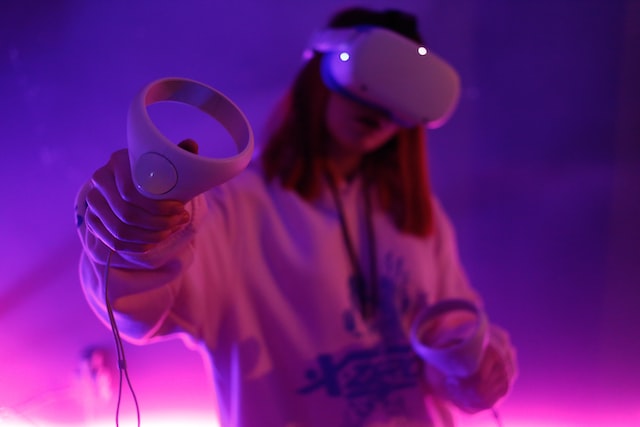The Metaverse and virtual reality (VR) are both forms of immersive technologies, but there are some key differences between them. The Metaverse is a massive shared digital world created by people and technology that can be accessed via the internet. It gives users an opportunity to connect with others in a variety of ways, including gaming, shopping, socializing, and exploring. VR, on the other hand, is an immersive digital experience that puts users in a simulated environment. It allows them to interact with virtual elements and explore different scenarios from the comfort of their home or workplace.
Introduction
What is the Metaverse?
The Metaverse is a term coined to describe the collective virtual shared space, created by the merging of both real and virtual worlds. It’s a concept that has been around for decades but was popularized in novels like Ready Player One and Snow Crash. The Metaverse is a growing convergence of virtual reality (VR), augmented reality (AR), and other technologies providing users with an ever-evolving digital environment that is open to exploration, creativity, and collaboration.
The Metaverse can be seen as a combination of the physical world and cyberspace – where physical objects are represented digitally, while digital objects exist in tangible form. This allows people from different parts of the world to connect virtually, much like how we communicate through social media. The Metaverse enables users to interact with each other through online avatars, as well as explore and experience a variety of virtual environments.
What is Virtual Reality?
Virtual reality (VR) is created using computer technology. When you use VR goggles or a headset, you are actually seeing computer-generated images. These images are generated by a process called rendering.
Rendering creates the images by calculating the position of objects in a 3D space and then drawing them on a 2D screen. This process is repeated many times per second to create the illusion of movement.
A person using virtual reality equipment is typically able to “look around” the artificial world, move about in it, and interact with virtual features or items. The effect is commonly created by VR headsets consisting of a head-mounted display with one or two small high-resolution OLED or LCD monitors providing separate images for each eye, stereoscopic headphones delivering sound to each ear, and head motion tracking sensors. Some VR systems also include tactile information, generally known as haptic feedback.
Haptic feedback is the sense of touch that can be simulated in virtual reality. This can be used to create the sensation of being able to touch, feel, and manipulate virtual objects. Most VR systems use some form of haptic feedback, which can be as simple as rumble motors in-game controllers or as complex as full-body suits that provide a variety of sensations.
Differences Between the Metaverse and VR
Social Interactions in Metaverse vs VR
Some social interactions in the Metaverse are similar to those found in the physical world. For example, people can meet up with friends and family members, chat, and play games together. Other social interactions are unique to the Metaverse. For example, people can explore virtual worlds together, or create and share digital content.
No matter what form they take, social interactions in the Metaverse are an important way for people to connect with each other and have fun. They also offer opportunities for businesses to reach new markets and engage with customers in an immersive environment.
As technology has advanced, social interactions in virtual reality (VR) have become increasingly possible. VR allows users to socialize and interact with others in a virtual world, offering new ways for people to connect remotely. With social interaction being an important part of our lives, it is impossible not to consider how this may be affected by the introduction of VR technology.
VR social interactions use a combination of audio and visuals to create an immersive experience which can help foster relationships between people. In addition, due to the low cost and convenience of using VR headsets, social interactions through the medium are becoming more commonplace than ever before. Through this platform users can play games with friends or coworkers, watch movies together and even participate in virtual meetings or conversations.
User Experience in the Metaverse vs VR

One of the key differences between the Metaverse and VR lies in their approach to user interaction. Whereas the Metaverse’s focus is on a shared, simulated universe, with users able to interact with one another through avatars, VR often takes a more immersive approach, creating an entirely separate world for each user. This means that metaverse UX must prioritize connection and socializing among users, while VR UX must focus on providing an immersive, individual experience.
Another difference between metaverse and VR lies in the way environments are constructed. In the Metaverse, users often control their environment, creating and customizing the space as they wish. VR environments are usually more pre-defined and structured, giving users less control over the direction of their experience. This means the Metaverse UX must be designed with a focus on creating an environment that is tailored to the user, while VR UX must prioritize making users feel as though they’re truly inside a different world.
Finally, the Metaverse and VR UX also differ in terms of the type of content they are designed to deliver. The Metaverse is often used for social interaction, gaming and multimedia activities such as watching movies or listening to music, while VR environments are typically used for more immersive activities such as virtual tours, training simulations and educational experiences. UX designers must be aware of these differences when developing Metaverse and VR applications, ensuring they create a user experience that is tailored to the needs of their audience.
Cost of Access in the Metaverse vs VR
In terms of hardware, VR requires specialized headsets and controllers in order to fully immerse users into their virtual world. These devices can range from hundreds to thousands of dollars depending on quality, making it an expensive undertaking for many people. In comparison, Metaverse access does not require any special hardware beyond what you would use for any other online activity. All you need is a computer or laptop with internet service and you’re good to go.
The cost difference doesn’t just stop with hardware either. Many Metaverse platforms offer free or low-cost access to their world, while VR experiences usually require users to purchase the software outright or pay for monthly subscriptions. This makes Metaverse access much more affordable than VR, making it a great way for those on a budget to explore the Metaverse.
It’s important to note that Metaverse access and VR experiences do not have to be mutually exclusive. Many Metaverse platforms offer experiences that can be enjoyed in both the Metaverse and VR environments, allowing users to have their cake and eat it too. However, for those who are looking to save money and still explore the Metaverse, Metaverse access is the way to go.
Conclusion
In conclusion, the Metaverse and VR are two distinct technologies with unique approaches to user interaction and content delivery. Metaverse access is more affordable than VR, making it a great option for those looking to explore the metaverse on a budget. However, both technologies have their own strengths and weaknesses and UX designers must be aware of these differences when creating applications for either platform. Whether you’re looking to socialize with friends or experience new worlds, there is sure to be something out there that meets your needs. So grab your headset or laptop and get ready to explore the Metaverse!

